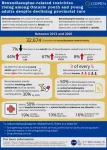(Press-News.org) Statement Highlights:
Nearly 1 in 3 Black adults may develop peripheral artery disease (PAD), compared to about 1 in 5 Hispanic or white adults. If amputation is necessary for treatment, Black, Hispanic and American Indian adults experience lower survival rates and worse quality of life after amputation compared to white adults.
Multiple social, economic and health variables contribute to disparities by sex, race and ethnicity in the development, diagnosis and treatment of PAD.
Opportunities to address disparities include greater focus on prevention in health care systems, increasing cultural competency and diversity among the physician workforce and public health efforts to raise awareness in affected communities.
Implementing routine preventive strategies, such as regular blood glucose testing, ankle blood pressure monitoring and foot exams for high-risk individuals, may decrease the risk of PAD complications and improve outcomes, particularly among people from diverse racial and ethnic groups.
Embargoed until 4 a.m. CT / 5 a.m. ET, Thursday, June 15, 2023
DALLAS, June 15, 2023 — Low-cost, routine testing may help to reduce disparities and health care costs for people with peripheral artery disease (PAD), according to a new scientific statement from the American Heart Association, published today in the Association’s flagship peer-reviewed journal Circulation.
The new scientific statement, “Health Disparities in Peripheral Artery Disease,” reviews the latest research, outlines racial and ethnic disparities in PAD diagnosis and treatment, and offers potential solutions to reduce disparities and increase health equity among people with PAD. Previous studies have found that PAD and its consequences disproportionately impact individuals who are Black, American Indian or Hispanic. These demographic groups experience both higher rates of PAD and worse PAD-related outcomes, such as disability, depression, coronary artery disease, cerebrovascular disease and/or limb amputation.
PAD is a narrowing of the arteries that carry blood to the extremities, often leading to reduced blood supply to the legs. It is the result of fatty plaque buildup in the arteries and causes pain, cramping or weakness in the legs and feet when walking. Approximately 1 in 10 people with PAD may develop chronic limb-threatening ischemia, where people experience pain even when resting, and they are at increased risk for limb amputation and death from cardiovascular disease. In addition, people with PAD who also have Type 2 diabetes have a higher rate of complications, including amputation, compared to people without Type 2 diabetes. More than 12 million people in the U.S. and 200 million people worldwide have PAD, and the majority of people living with PAD are ages 40 and older.
The statement advises routine, low-cost preventive screening and monitoring for people with PAD that includes hemoglobin A1c testing (a measure of blood glucose as a 3-month average), ankle-brachial index measurements (a comparative test of blood pressure at the ankle vs. arm to monitor blood flow) and, for those with Type 2 diabetes, foot exams to check for ulcerations and neuropathy.
“This debilitating condition has devastating outcomes such as major limb amputation, which often leads to lower quality of life and increased disability, and results in social and economic burden for individuals and their families, and places an enormous financial burden on the health care system,” said statement writing group member Carlos Mena-Hurtado, M.D, an associate professor of cardiology and director of vascular medicine at Yale New Haven Hospital and Yale University in New Haven, Connecticut. ”High-risk patients should routinely receive low-cost preventive measures. Preventing problems before they occur may help to improve quality of life and reduce health care costs in the long run for people with PAD.”
Some of the disparities identified in the statement include:
Nearly 1 in 3 Black adults may develop PAD, compared to about 1 in 5 Hispanic or white adults.
When seeking medical care, Black adults are more likely to have more advanced PAD and are more likely to undergo leg or foot amputation in comparison to peers who are white adults.
Compared to white adults, Black, Hispanic and American Indian adults experience lower survival rates and worse quality of life after amputation. People in these demographic groups are also less likely to use a prosthesis to regain the ability to walk and more likely to live in a nursing home.
People from underrepresented racial and ethnic groups also have an increased risk of death after amputation, with the rate of death within five years ranging from 45%–60%, depending on the location of the amputation.
Limited access to health care resources may play a role in differences in outcomes for patients with PAD. Underrepresented, rural and low-income adults are at greater risk of being uninsured and are more likely to seek care at a more advanced stage of the disease compared with white, urban and higher-income adults, which increases the risk for amputation.
Mena-Hurtado added, “Even after controlling for traditional cardiovascular risk factors, we were surprised to find that higher PAD prevalence persists among Black adults. However, we now know that social determinants of health, such as access to nutritious foods, walkable neighborhoods and structural inequities, have a profound impact on an individual’s health status.”
Disparities in Risk Factors for PAD
Smoking is the most important risk factor for PAD. According to the statement, people who are of American Indian and Alaska Native descent have higher rates of smoking than people from other racial and ethnic groups. Although smoking rates have decreased in the U.S. overall, the decline has been lower among Black and American Indian adults.
Other risk factors for PAD include Type 2 diabetes, high blood pressure, high cholesterol and obesity. People who are Black or Hispanic have higher rates of obesity compared with white adults in the U.S. In addition, Black adults with PAD also have higher rates of Type 2 diabetes, high blood pressure and chronic obstructive pulmonary disease (COPD) than white adults.
Differences in vascular health may also contribute to higher rates of PAD among Black adults. Social determinants of health have been linked to alterations in blood vessel function and increased blood vessel aging and stiffness, which, in turn, increase the risk of PAD. Several studies have found Black adults are more likely to have accelerated vascular aging, reduced endothelial function, increased arterial stiffness and elevated biomarkers of systemic inflammation, which are associated with an increased risk of cardiovascular disease.
Potential Solutions to Reduce Disparities
The statement suggests opportunities to reduce disparities in PAD care from three perspectives:
a system-wide approach that integrates PAD screening into routine care;
improving cultural competence and increasing diversity of clinicians and physicians; and
improving community education and support programs.
The writing group suggests that emerging advances in telehealth appointments and remote patient monitoring may help to expand access to routine and preventive care. Broader implementation of telehealth and remote monitoring may help to reduce the disproportionately high number of amputations throughout the U.S., in general, and especially among people from diverse racial and ethnic groups.
Community health efforts aimed at increasing public awareness and knowledge about PAD may also help improve patient outcomes. As an example, the statement cites novel approaches to deliver health care and raise awareness among Black men, such as barbershop-based screening and follow-up. Studies have shown that community-based care and support programs are effective to lower blood pressure and raise awareness of PAD.
Quitting smoking, improving diet and exercise therapy are critical to reducing cardiovascular risk, mortality and amputation rates in people with PAD. Interventions that increase access to healthy foods, and ensure sensitivity to diverse cultural eating patterns may help to reduce hospital admissions and health care costs. Examples include programs that partner with food banks and implement community gardens.
For people with established PAD, medications to manage blood pressure, lower cholesterol and reduce blood clotting may be considered to reduce the risk of heart attack, stroke, amputation and cardiovascular death. Surgical revascularization procedures that restore blood flow in blocked arteries, such as lower extremity arterial bypass, were found to be less likely to be offered in certain regions of the U.S., especially among Black, Hispanic and American Indian populations. Greater access to these procedures and follow-up care may also help to reduce disparities.
“It is essential that health care professionals understand the disparities in PAD prevalence and outcomes in order to provide appropriate, evidence-based care and bridge the gaps in the treatment of this diverse patient population. Health care systems need to optimize cost-effective interventions at every step,” Mena-Hurtado.
The American Heart Association and 25 other organizations have developed the PAD National Action Plan to increase public awareness and understanding of PAD, prevent complications, address health barriers and improve quality of life for people living with the condition.
American Heart Association scientific statements promote greater awareness about cardiovascular diseases and stroke issues and help facilitate informed health care decisions. Scientific statements outline what is currently known about a topic and what areas need additional research. While scientific statements inform the development of guidelines, they do not make treatment recommendations.
Members of the writing group and disclosures are listed in the manuscript.
The Association receives funding primarily from individuals. Foundations and corporations (including pharmaceutical, device manufacturers and other companies) also make donations and fund specific Association programs and events. The Association has strict policies to prevent these relationships from influencing the science content. Revenues from pharmaceutical and biotech companies, device manufacturers and health insurance providers, and the Association’s overall financial information are available here.
Additional Resources:
Available multimedia is on the right column of the news release link. https://newsroom.heart.org/news/nearly-1-in-3-black-adults-may-develop-pad-disparities-in-care-increase-amputation-risk?preview=c509a51f49593d4c82555976cd5a5647
Spanish news release (to be added)
After June 15, view the manuscript online.
2016 AHA/ACC Guideline on the Management of Patients With Lower Extremity Peripheral Artery Disease
Symptoms, Quality of Life Important to Guide Treatment for Peripheral Artery Disease (PAD) (Nov. 2022)
Restored blood flow meant less pain, better quality of life for those with leg artery disease (Nov. 2022)
Follow AHA/ASA news on Twitter @HeartNews
About the American Heart Association
The American Heart Association is a relentless force for a world of longer, healthier lives. We are dedicated to ensuring equitable health in all communities. Through collaboration with numerous organizations, and powered by millions of volunteers, we fund innovative research, advocate for the public’s health and share lifesaving resources. The Dallas-based organization has been a leading source of health information for nearly a century. Connect with us on heart.org, Facebook, Twitter or by calling 1-800-AHA-USA1.
###
END
Nearly 1 in 3 Black adults may develop PAD; disparities in care increase amputation risk
Routine, low-cost testing may reduce disparities and health care costs for people with peripheral artery disease (PAD), according to new American Heart Association scientific statement
2023-06-15
ELSE PRESS RELEASES FROM THIS DATE:
Mapping the evolution of E. coli’s main virulence factor offers a refined drug target
2023-06-15
This new work focused on a particular subset of E. coli with a specific capsule - the extracellular barrier that surrounds a bacterium - which scientists have called K1. E. coli with this type of capsule are known to cause invasive diseases such as bloodstream or kidney infections, and meningitis in newborns. This is because this particular cover allows them to mimic molecules already present in human tissues and enter the body unnoticed.
The researchers present evidence that targeting the capsule can be used ...
Only 30% of show horse owners surveyed in Australia agreed with facial hair trimming ban, new study reveals
2023-06-15
New research published in the CABI journal Human-Animal Interactions has revealed that only 30% of show horse owners surveyed in Australia agreed with a ban on the trimming of facial hair prior to its implementation in July 2022.
The research found that when asked if facial hair trimming should be banned in all equine competitions, most disciplines broadly agreed (60.5% to 84.6%) apart from showing with only 22.9% of respondents agreeing with a ban.
Indeed, some who took part in the research also believed that horses did ...
Chronic wound healing using glass
2023-06-15
Researchers at the University of Birmingham have demonstrated that silver retains antimicrobial activity for longer when it is impregnated into ‘bioactive glass’, and shown for the first time how this promising combination delivers more long-lasting antimicrobial wound protection than conventional alternatives.
Bioactive glasses are a unique class of synthetic biomaterials made from silicone and have been used for some years in bone grafting.
Silver has long been known to prevent or reduce the growth ...
Finding out you’re autistic in later life can be a positive experience
2023-06-15
Receiving an autism diagnosis in your 20, 30s, 40s, 50s or even 60s may seem daunting, but a new study from psychologists in Bath and London finds that the link between the age at which someone gets diagnosed has little bearing on their quality of life.
So-called ‘late diagnosis’ for autism has hit the headlines recently thanks to autism campaigner Christine McGuiness. Whereas autism is usually diagnosed in childhood, it is increasing being diagnosed in adults and especially among women.
Parents often wonder if their child finding out they are autistic earlier or later will have an impact on their lives in the long term. Whilst many people who discover they are autistic as adults ...
Rising rates of benzodiazepine toxicity among young people spark concern
2023-06-15
Toronto, ON, June 15, 2023 – The rate of hospital encounters for benzodiazepine-related toxicity rose by 67 per cent for young adults (aged 19 to 24) and 44 per cent for youth (aged 18 or below) in Ontario between 2013 and 2020, according to a new study from ICES and Unity Health Toronto.
Though there was an overall decline of 7 per cent in the provincial rate of benzodiazepine toxicity, this was largely driven by reductions in rates among people aged 35 years and older.
Benzodiazepines are commonly prescribed to treat anxiety ...
How antelopes under threat from the climate crisis have responded to rising temperatures
2023-06-15
The climate crisis is turning the temperature up all over the world, but in southern Africa, the rise has been particularly concerning. Wild animals dependent on delicate ecosystems which are already dry, so that food and water scarcity limits their ability to cope with increased heat, are at serious risk. Scientists studied the behavior of three different species of antelope with overlapping ranges in Namibia to try to understand how animals of different sizes and behaviors adapt to the heat.
“Even the indigenous wildlife, adapted to hot and arid conditions, shows sensitivity to extreme heat,” said Paul Berry of the University of Potsdam, lead author of the study in ...
Dialogues across language and culture
2023-06-15
Teacher talk seems intuitive – the expert imparts knowledge onto novices, who passively receive expertise like a car or machine receives parts at every station on an assembly line. In reality, an effective teacher in an era of dynamic and higher literacies is less of a factory worker and more of an active negotiator who tries to understand where their students are coming from in order to reach them. The language classroom amplifies this challenge where the negotiation not only centers on the knowledge itself but the means of communication for that knowledge. ...
Access to financial services linked to lower COVID mortality rates
2023-06-15
New research shows that some of the best tools to decrease COVID-19 mortality rates weren’t found in the ER, but rather at the bank.
A study of COVID-19 mortality rates across 142 nations has demonstrated a surprisingly strong link between access to formal financial services and lower COVID-19 mortality rates. In fact, it’s proved to be as strong a predictor of lower COVID-19 death rates as several comorbidities are of higher COVID-19 death rates.
“The reduction is surprisingly large, similar in magnitude to, but opposite in direction from, the mortality risks associated with higher rates of lung cancer and hypertension,” says Todd Watkins, ...
Men died of overdose at 2-3 times greater a rate than women in the U.S. in 2020-2021
2023-06-15
Men were significantly more vulnerable than women to overdose deaths involving opioid and stimulant drugs in 2020-2021, according to a new study analyzing death records data from across the United States. The study found that men had a 2–3 times greater rate of overdose mortality from opioids (like fentanyl and heroin) and psychostimulants (like methamphetamine and cocaine). While it has been known that men use drugs at higher rates than women, the researchers found that this alone does not explain the gap in overdose deaths, noting that biological, behavioral, and social factors likely ...
A marine mystery: Discovering the link between climate change and sea sponge loss
2023-06-15
Sea sponges are essential to marine ecosystems. They play critical roles in the ocean, as they provide shelter and food to a plethora of marine creatures, recycle nutrients by filtering thousands of litres of sea water daily, and are hosts to microbes that may be the key to some of the most pressing medical challenges we face today.
Now, scientists from UNSW have discovered that when a tropical sea sponge is exposed to warmer temperatures, it loses an important microbe, which could explain why the sponge tissue dies. The latest study, published today in ISME Communications, has revealed that by exposing sea sponges ...
LAST 30 PRESS RELEASES:
This self-powered eye tracker harnesses energy from blinking and is as comfortable as everyday glasses
Adverse prenatal exposures linked to higher rates of mental health issues, brain changes in adolescents
Restoring mitochondria shows promise for treating chronic nerve pain
Nature study identifies a molecular switch that controls transitions between single-celled and multicellular forms
USU chemists' CRISPR discovery could lead to single diagnostic test for COVID, flu, RSV
Early hominins from Morocco reveal an African lineage near the root of Homo sapiens
Small chimps, big risks: What chimps show us about our own behavior
We finally know how the most common types of planets are created
Thirty-year risk of cardiovascular disease among healthy women according to clinical thresholds of lipoprotein(a)
Yoga for opioid withdrawal and autonomic regulation
Gene therapy ‘switch’ may offer non-addictive pain relief
Study shows your genes determine how fast your DNA mutates with age
Common brain parasite can infect your immune cells. Here's why that's probably OK
International experts connect infections and aging through cellular senescence
An AI–DFT integrated framework accelerates materials discovery and design
Twist to reshape, shift to transform: Bilayer structure enables multifunctional imaging
CUNY Graduate Center and its academic partners awarded more than $1M by Google.org to advance statewide AI education through the Empire AI consortium
Mount Sinai Health system receives $8.5 million NIH grant renewal to advance research on long-term outcomes in children with congenital heart disease
Researchers develop treatment for advanced prostate cancer that could eliminate severe side effects
Keck Medicine of USC names Christian Pass chief financial officer
Inflatable fabric robotic arm picks apples
MD Anderson and SOPHiA GENETICS announce strategic collaboration to accelerate AI-driven precision oncology
Oil residues can travel over 5,000 miles on ocean debris, study finds
Korea University researchers discover that cholesterol-lowering drug can overcome chemotherapy resistance in triple-negative breast cancer
Ushikuvirus: A newly discovered giant virus may offer clues to the origin of life
Boosting the cell’s own cleanup
Movement matters: Light activity led to better survival in diabetes, heart, kidney disease
Method developed to identify best treatment combinations for glioblastoma based on unique cellular targets
Self-guided behavioral app helps children with epilepsy sleep earlier
Higher consumption of food preservatives is associated with an increased risk of type 2 diabetes
[Press-News.org] Nearly 1 in 3 Black adults may develop PAD; disparities in care increase amputation riskRoutine, low-cost testing may reduce disparities and health care costs for people with peripheral artery disease (PAD), according to new American Heart Association scientific statement



